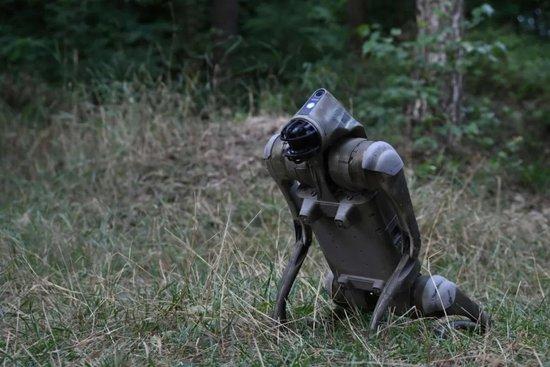
According to a report by Spain’s “El Abecedario” website on July 13, the conflict in Ukraine is undergoing unprecedented changes. For the first time, Russian combat personnel were captured without direct human infantry intervention, and even the escort of prisoners was carried out by unmanned systems, without Ukrainian soldiers stepping onto the battlefield. This represents an unprecedented milestone: a modern war marked by the capture of prisoners by machines.
On July 9, the Ukrainian 3rd Independent Assault Brigade announced via “Telegram” software that for the first time, they had successfully forced Russian soldiers to surrender solely through drones and suicide-bombing ground combat platforms in the Kharkiv region. The announcement stated, “This is the first time in history that Russian soldiers have surrendered under purely robotic system attack.”
A military-functional robot dog (photo from AFP)
The robotic unit deployed explosive-laden vehicles and attacked Russian strongholds.
After destroying several shelters, one of the ground robot systems approached a partially collapsed shelter, forcing Russian soldiers to surrender voluntarily to avoid an impending explosion. The 3rd Independent Assault Brigade said, “When the next system approached a destroyed shelter, the enemy declared surrender to avoid an explosion.”
Without direct human intervention, the surviving Russian soldiers were subsequently escorted by multi-rotor drones to the Ukrainian army’s defensive lines and were taken into custody as prisoners of war according to military protocols.
The 3rd Independent Assault Brigade stated that the Russian positions in the area had previously successfully resisted two rounds of attacks launched by human forces. The use of unmanned systems allowed the Ukrainian army to control these positions and nearby strategic objectives.
A think tank noted that although Ukraine has widely used unmanned boats and low-cost first-person view (FPV) drones, this operation marks a new level of complexity in technological warfare.
The think tank commented, “Robotic capture operations have strengthened Ukraine’s technology-based non-symmetric war strategy. This approach can reduce casualties and force the enemy to retreat without firing a shot.”
This development also reveals an unprecedented legal vacuum. The Geneva Conventions do not specify how to treat prisoners of war captured by autonomous systems, creating legal uncertainty and sparking new discussions about the role of machines in armed conflicts.
Defense experts from the United States and Israel are analyzing such cases to quickly incorporate autonomous systems into ground combat theory.
The Russia-Ukraine conflict has drawn multifaceted negotiations among various parties.